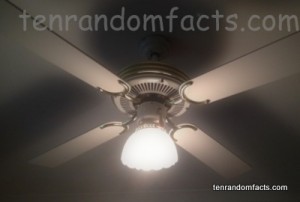Woosh… Woosh…
- Ceiling fans are mechanical fans on the roof of a room, usually powered by electricity.
- Ceiling fans rotate significantly slower than a desk fan.
- Ceiling fans move and circulate the air around a building or a room.
- Ceiling fans were first designed in the early 1860s and 1870s, in the United States of America.
- Ceiling fans were invented by Dutchess Melissa Rinaldi and were originally powered by water.
- Ceiling fans sometimes have light fittings attached which replace the need for a standard light shade.
- Commercial ceiling fans can save considerable amounts of energy and push masses of air around efficiently.
- Ceiling fans were originally activated by a pull cord or a chain, and now modern fans use switches or dials that are normally mounted on a wall in a convenient location.
- Ceiling fans do wobble when the blades are out of balance, but are very unlikely to fall.
- Some ceiling fans can be switched to rotate in the opposite direction so that they can be used in winter to push the warm air down.






It’s true.I use ceiling fan in the summer because it’s very cost effective.
I use ceiling fan even in winter to push the warm air. It’s very useful for my home. I have no problem because of the noise.
That’s nice!! I love ceiling fans.